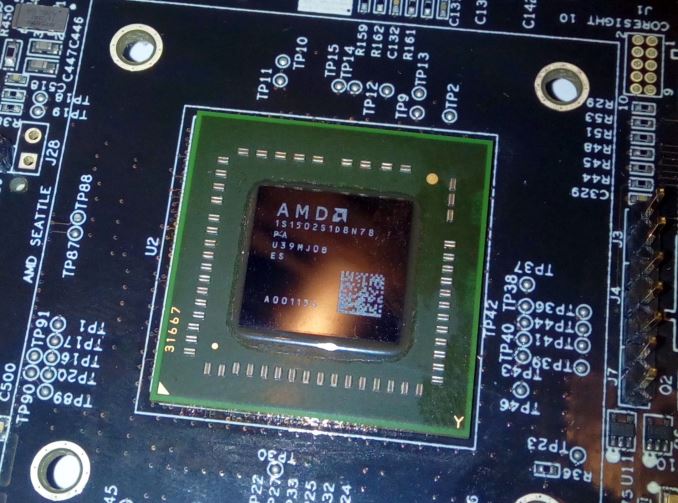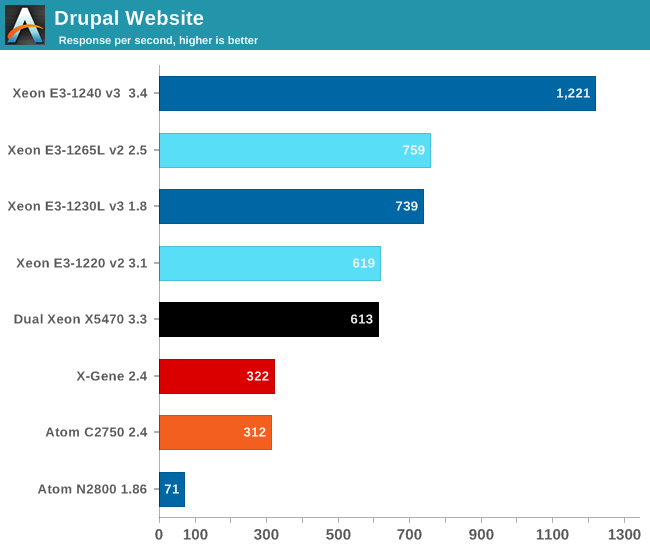The Silver Lining of the Late AMD Opteron A1100 Arrival
by Johan De Gelas on January 14, 2016 1:19 PM EST- Posted in
- Cloud Computing
- AMD
- Arm
- Opteron
- Opteron A1100

AMD announced their ARM server SoC plans at the end of 2012. At the beginning of 2014, AMD was ready "to accelerate the ARM Server Ecosystem with the first ARM-based server SoC" with a development kit. Around March 2014, the A1100 SoCs started sampling. But the quad core dev kits were not only expensive ($3000!), they also had quite a bit of teething problems as performance did not meet expectations, some of the peripheral hardware did not work properly, and the software ecosystem was far from ready. We were expecting to see Opteron A1100 based servers at the end of 2014, but instead we got more than a year of almost complete silence. Frustratingly long for anyone who was hoping that AMD would finally bring something competitive to the server world.
Today, AMD is finally announcing that their Octal core Opteron A1100 server SoC and platform is fully ready as "a right sized option for the edge of the datacenter". A few smaller partners are even shipping it. but there is no sign of tier 1 OEMs yet. Most people following this part of the semiconductor part are thinking "too little, too late". We are pretty sure that includes you, dear reader. But there is more than meets the eye or we would not bother to write this article.
Cards On the Table
AMD is launching 3 SKUs and the spec table is available below.
From the early reports, performance is somewhere between 80 to 90% of the Atom C2750 (Eight 2.4 GHz Silvermont cores at 2.4-2.6 GHz). Even if AMD has used the delay to tune the A1100 significantly, it is very unlikely that the chip will be able to beat the Atom chip by any tangible margin.
The performance per watt ratio of the 28 nm ARM Opteron is not stunning either: a TDP of 32W at 2 GHz is worse than the 20W that the 22 nm C2750 needs at 2.4 GHz. Of course, TDP is one thing, the real power consumption at low and medium loads is more important for a server SoC. Nevertheless, we were promised an octal core at Atom C2750 levels at 25W TDP.
And last but not least, the Atom has been available for more than 2 years now. Its successor, Denverton - or the 14 nm Atom C3xxx - should arrive in the second half of 2016. But Intel is late too, as Denverton was also supposed to be in the market by early 2015. Contrary to AMD however, is Intel executing very well in all other server markets. With the much less than hyped/predicted growth of the microserver market, it is only natural that Intel prioritize other products in its datacenter portefolio.
Overall the A1100's 32W TDP looks high and performance expectations are low, so why bother? Pricing perhaps? Unfortunately the answer to that will be "no," as AMD told us that the initial price of the A1170 SoC will be $150. That is the same price of the Atom C2730 (eight cores at 1.7 GHz), which will probably perform at the same level, but the Intel chip is a 12W TDP chip. At $150 the A1100 even comes dangerously close to the quad core, 8 thread Xeon D-1520 at 2.2 GHz ($199). Do not let the 4-cores fool you, we found that the octal core (16 thread) Xeon D-1540 is no less than 5.5 times faster than an Atom C2750 in real server workloads. Take a look below.

The A1100 will probably score around 300, the Xeon D-1520 will probably score beyond 600. So an Xeon D-1520 will still be at least twice as fast as an Atom C2750 or Opteron A1100. So the new AMD SoC has no performance/watt advantage and no price/performance advantage over Intel's offerings.











37 Comments
View All Comments
Lonyo - Thursday, January 14, 2016 - link
In terms of manufacturing and performance, since Samsung recently inked to fab some Qualcomm systems, and GloFo/Samsung have a partnership, is there not potential for a somewhat rapid improvement in process to use an advanced, up and running and potentially available capacity 16nm process from Samsung within a short period of time? (<18 mo) to bring them closer to the new Atoms that are due.Kevin G - Thursday, January 14, 2016 - link
In 18 months we should be looking at the arrival of AMD's K12 chip if all goes according to plan.nandnandnand - Thursday, January 14, 2016 - link
K12 is expected to be on a 14/16nm process, right?medi03 - Friday, January 15, 2016 - link
Most likely 14nm (Samsung's process, with GloFo on board)Jtaylor1986 - Thursday, January 14, 2016 - link
Why did you ever both to write this article? I hope 2 pages of bashing AMD got whatever grievance you had out of your system. I will look forward to more professional articles in the future.Lonyo - Thursday, January 14, 2016 - link
I could 1 page of bashing AMD for being late and non-competitive in raw number terms. Then 2 pages of explaining potential use cases.Lonyo - Thursday, January 14, 2016 - link
*Count.Jtaylor1986 - Thursday, January 14, 2016 - link
Begs the question why cover it at all if this is a totally uncompetitive product that is effectively dead on arrival. Why spend resources covering a product nobody will ever buy when there are numerous products lots of people buy they haven't covered.eanazag - Thursday, January 14, 2016 - link
Cover it because it is finally done. Plus 14 SATA 3 connectors and dual 10 GigE is nothing to scoff at. Add to that a good size of DDR4 ECC RAM and we have something to think about. I suggest you price shop dual 10 GigE for less than $400 and see what you get. I think those items make it worth considering despite the proc being uncompetitive on several fronts. Don't be confused; this is a niche system. This is not a jack of all trades setup.beginner99 - Friday, January 15, 2016 - link
Still even for real use (business) or just for myself for fiddling around I would go with the Xeon-D. It's just so much more powerful. Yes it costs more but not much. Even if its $500 vs.$ 1000. Software you run on that will cost 10x times of that amount.